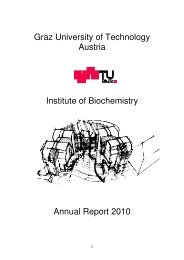Staff Members of the Institute of Biochemistry, TU - Institut für ...
Staff Members of the Institute of Biochemistry, TU - Institut für ...
Staff Members of the Institute of Biochemistry, TU - Institut für ...
You also want an ePaper? Increase the reach of your titles
YUMPU automatically turns print PDFs into web optimized ePapers that Google loves.
characteristics <strong>of</strong> <strong>the</strong>se two TAG synthases <strong>of</strong> <strong>the</strong> oleaginous yeast are currently under<br />
investigation.<br />
Is <strong>the</strong> function <strong>of</strong> Nte1p conserved from yeast to man?<br />
Neuropathy target esterase (NTE) was originally identified as <strong>the</strong> target <strong>of</strong><br />
organophosphorous esters (OP) present in many pesticides as well as warfare agents.<br />
Toxifications with OPs are causing delayed neuropathy in man and some o<strong>the</strong>r vertebrates.<br />
The syndrome <strong>of</strong> <strong>the</strong> organophosphorous-induced delayed neuropathy (OPIDN) is<br />
characterized by paralysis <strong>of</strong> <strong>the</strong> lower limbs and degeneration <strong>of</strong> long axons in <strong>the</strong> spinal<br />
cord. These effects are common responses <strong>of</strong> neurons in metabolic disorders (e.g., diabetes),<br />
toxic states and advanced age. Nei<strong>the</strong>r NTE nor its homologs in o<strong>the</strong>r organisms are closely<br />
related to any o<strong>the</strong>r esterase or protease. The importance <strong>of</strong> NTE can be seen by <strong>the</strong> fact that<br />
mice lacking this protein die as early embryos, and inactivation <strong>of</strong> SWS (swiss cheese), <strong>the</strong><br />
homolog <strong>of</strong> NTE in <strong>the</strong> fruit fly Drosophila melanogaster, leads to a progressive degeneration<br />
<strong>of</strong> <strong>the</strong> nervous system, which can be observed as big “holes” in <strong>the</strong> brain <strong>of</strong> <strong>the</strong> fly.<br />
Wild type, 21d sws, 8d<br />
Figure 2: “Holes” in <strong>the</strong> brain <strong>of</strong> a sws-mutant <strong>of</strong> <strong>the</strong> fruit fly Drosophila melanogaster.<br />
Heterologous expression <strong>of</strong> <strong>the</strong> murine NTE can completely substitute SWS in Drosophila,<br />
demonstrating <strong>the</strong> functional conservation <strong>of</strong> this protein. A homolog <strong>of</strong> NTE is also present<br />
in <strong>the</strong> yeast Saccharomyces cerevisiae encoded by NTE1. In contrast to higher eukaryotes,<br />
deletion <strong>of</strong> this protein in <strong>the</strong> model organism yeast does not result in a phenotype under<br />
several standard conditions tested. However, due to <strong>the</strong> presence <strong>of</strong> this polypeptide in a<br />
single cell organism, NTE has to be involved in a more general context as in development,<br />
neural survival and brain integrity. All efforts to identify <strong>the</strong> biological function, substrate,<br />
and interaction partners <strong>of</strong> NTE in higher eukaryotes have failed so far. In contrast, Nte1p <strong>of</strong><br />
<strong>the</strong> yeast has been reported to exhibit phospholipase B activity, thus indicating a similar<br />
function <strong>of</strong> <strong>the</strong> respective counterparts <strong>of</strong> higher eukaryotes. The question arises whe<strong>the</strong>r<br />
Nte1p <strong>of</strong> Saccharomyces cerevisiae is a true member <strong>of</strong> <strong>the</strong> NTE protein family and thus<br />
suitable as a model for unraveling <strong>the</strong> biological function <strong>of</strong> <strong>the</strong> NTE protein family. In vitro,<br />
<strong>the</strong> functional conservation between NTE <strong>of</strong> higher eukaryotes and Nte1p <strong>of</strong> <strong>the</strong> yeast has<br />
already been demonstrated. But is this also true in vivo? For answering this question, I<br />
expressed NTE1 <strong>of</strong> <strong>the</strong> yeast heterologously in <strong>the</strong> fruit fly Drosophila melanogaster. A<br />
functional compensation would be indicated by reversion <strong>of</strong> <strong>the</strong> phenotype <strong>of</strong> an sws mutant<br />
25














